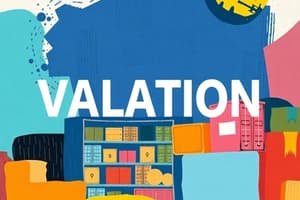Podcast
Questions and Answers
What are the different patterns of inventories mentioned in the text?
What are the different patterns of inventories mentioned in the text?
Raw materials, spares, stores, work-in-progress, finished goods
What is the major component of working capital for every concern?
What is the major component of working capital for every concern?
Inventory
According to Accounting Standard 2, how should inventories be valued?
According to Accounting Standard 2, how should inventories be valued?
At lower of cost of inventory or net realizable value (NRV) of the inventory
How is the valuation of inventory determined as per AS-2 when dealing with finished goods or work-in-progress?
How is the valuation of inventory determined as per AS-2 when dealing with finished goods or work-in-progress?
What information is provided in the text about the value of inventory for Chemical 1 and Chemical 2 in Illustration-2?
What information is provided in the text about the value of inventory for Chemical 1 and Chemical 2 in Illustration-2?
What is the meaning of Inventory as per AS-2?
What is the meaning of Inventory as per AS-2?
What are the features of Inventory?
What are the features of Inventory?
Why is the valuation of Inventory as per AS-2 significant?
Why is the valuation of Inventory as per AS-2 significant?
What are the different methods of pricing the issue of materials?
What are the different methods of pricing the issue of materials?
What becomes the opening stock of the next accounting year?
What becomes the opening stock of the next accounting year?
Flashcards
What are the different types of inventory?
What are the different types of inventory?
Raw materials, spares, stores, work-in-progress, and finished goods are all types of inventory.
What is the main component of working capital?
What is the main component of working capital?
Inventory is the most important part of working capital for any business.
How is inventory valued under AS-2?
How is inventory valued under AS-2?
According to Accounting Standard 2 (AS-2), inventory should be valued at the lower of its cost or its net realizable value (NRV).
How is inventory valued for finished goods and work-in-progress?
How is inventory valued for finished goods and work-in-progress?
Signup and view all the flashcards
What is inventory according to AS-2?
What is inventory according to AS-2?
Signup and view all the flashcards
Why is the valuation of inventory according to AS-2 important?
Why is the valuation of inventory according to AS-2 important?
Signup and view all the flashcards
What are the different methods used to price the issue of materials?
What are the different methods used to price the issue of materials?
Signup and view all the flashcards
What becomes the opening stock of the next accounting year?
What becomes the opening stock of the next accounting year?
Signup and view all the flashcards
Why is inventory valuation important for profitability?
Why is inventory valuation important for profitability?
Signup and view all the flashcards
Why is inventory management crucial?
Why is inventory management crucial?
Signup and view all the flashcards




